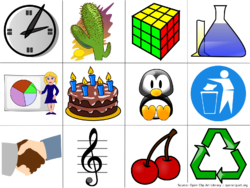Clip art
This article needs additional citations for verification. (December 2014) |

Clip art (also clipart, clip-art) is a type of
History
The term "clipart" originated from the practice of physically cutting images from pre-existing printed works for use in other publishing projects. Originally called "printer's cuts," "stock cuts" or "electrotype cuts,"[1] before the advent of computers in desktop publishing, clip art was used through a process called paste up. Many clip art images of this era qualified as line art. In this process, the clip art images are cut out by hand from booklets or sheets sold by stock art studios or print companies (such as Dynamic Graphics[2] or Volk Clip Art) and then attached via adhesives to a board representing a scale size of the finished, printed work. After the addition of text and art created through phototypesetting or dry-transfer lettering, the finished, camera-ready pages (called mechanicals) were sent to print.
Since the 1990s, nearly all publishers have replaced the paste up process with

After 1986, desktop publishing generated a widespread need for pre-made, electronic images as consumers began to produce newsletters and brochures using their own computers. Electronic clip art emerged to fill the need. Early electronic clip art was simple line art or bitmap images due to the lack of sophisticated electronic illustration tools. With the introduction of the Apple Macintosh program MacPaint, consumers were provided the ability to edit and use bit-mapped clip art for the first time. One of the first successful electronic clip art pioneers was T/Maker Company, a Mountain View, California, company, which had its early roots with an alternative word processor WriteNow, commissioned for the Macintosh by Steve Jobs. Beginning in 1984, T/Maker took advantage of the capability of the Macintosh to provide bit-mapped graphics in black and white; by publishing small, retail collections of these images under the brand name "ClickArt". The first version of "ClickArt" was a mixed collection of images designed for personal use. The illustrators who created the first "serious" clip art for business/organizational (professional) use were Mike Mathis, Joan Shogren, and Dennis Fregger; published by T/Maker in 1984 as "ClickArt Publications".
In 1986, the first vector-based clip art disc was released by Composite, a small desktop publishing company based in Eureka, California. The black-and-white art was painstakingly created by Rick Siegfried with MacDraw, sometimes using hundreds of simple objects combined to create complex images. It was released on a single-sided floppy disc. Also in 1986,
With the widespread adoption of the CD-ROM in the early 1990s, several pre-computer clip art companies such as Dover Publications also began offering electronic clip art.
The mid-1990s ushered in more innovation in the clip art industry, as well as a marketing focus on quantity over quality. Even T/Maker, whose success was built upon selling small, high-quality clip art packages of approximately 200 images, began to get interested in the volume clip art market. In March 1995, T/Maker became the exclusive publisher of over 500,000 copyright-free images which was, at the time, one of the world's largest clip art libraries. This licensing agreement was subsequently transferred to Broderbund. In 1996, Zedcor (later rebranded to ArtToday, Inc. and then Clipart.com) was the first company to offer clip art images, illustrations, and photos for download as part of an online subscription. Also during this period, word processing companies, including Microsoft, began offering clip art as a built-in feature of their products. In 1996, Microsoft Word 6.0 included only 82 WMF clip art files as part of its default installation. In 2014, Microsoft offered clip art as part of over 140,000 media elements on the Microsoft Office website.
Other companies such as Nova Development and Clip Art Incorporated also pioneered the marketing of large clip art collections in the late 1990s, including Nova's "Art Explosion" series, which sold clip art in increasingly large libraries up to a million images. Between 1998 and 2001, T/Maker's clip art assets were sold each year as a result of some of the largest mergers and acquisitions in the computer software industry, including those of
In the early 2000s, the World Wide Web continued to gain popularity as a retail software distribution channel, and several other companies started to license clip art through online, searchable libraries, including iCLIPART.com (part of Vital Imagery Ltd.), WeddingClipart.com (part of Letters and Arts Incorporated), and GraphicsFactory.com (part of Clip Art Incorporated). Because of the Web, clip art is now not only sold through retail channels as packaged bundles of images, but also as individual images and subscriptions to entire libraries (which allow you to download an unlimited number of images for the duration of the subscription). In the mid-2000s, the clip art market is segmented in several different ways, including the data type, the art style, the delivery medium, and the marketing method.
On December 1, 2014, Microsoft officially ended its support for the online Clip Art library in
File formats

Electronic clip art is available in several different
Clip art file formats are divided into 2 different types:
In contrast to the grid format of bitmap images,
Image rights

All clip art usage is governed by the terms of individual copyrights and usage rights. The copyright and usage rights of a clip art image are important to understand so that the image is used in a legal, permitted way. The three most common categories of image rights are
Most commercial clip art is sold with a limited royalty free license which allows customers to use the image for most personal, educational and non-profit applications. Some royalty free clip art also includes limited commercial rights (the right to use images in for-profit products). However, royalty free image rights often vary from vendor to vendor. Some fine art, clip art is still sold on a rights managed basis. However this type of image rights have seen a steep decline in the past 20 years as royalty free licenses have become the preferred model for clip art. Public domain images continue to be one of the most popular types of clip art because the image rights are free. However, many images are erroneously described as part of the public domain are actually copyrighted, and thus illegal to use without proper permissions. The main cause for this confusion is because once a public domain image is redrawn or edited in any way, it becomes a brand new image which is copyrightable by the editor.
The United States District Court ruled in 1999 as part of
The popularity of the Web has facilitated widespread copying of
See also
- Icon set
- Graphic design
- Non-photo blue
References
- ^ "Scanning Around With Gene: Profile of An Early Clip Art Character | CreativePro Network". 2007-05-16. Retrieved 2023-10-03.
- ^ "Dynamic Graphics Clipper Index Creative Art Service Clip Art Book 06/74 - 07-76". eBay. Retrieved 2023-10-03.
- ^ Team, Office 365 (1 December 2014). "Clip Art now powered by Bing Images". blogs.office.com.
{{cite web}}: CS1 maint: numeric names: authors list (link) - ^ Walter, Derek (December 14, 2014). "How to find images for Office documents now that Microsoft's killing Clip Art". PC World. Retrieved August 12, 2017.
- ^ "ClipArt ETC: Free Educational Illustrations for Classroom Use". etc.usf.edu.
External links
- Clip art at Curlie
- Extensive clip art collection - free to use by the public domain.
- Original clip art - free to use for non-commercial projects.
- Free clip art - free clip art images in high resolution.
- 1010clipart - free Clip Art in AI, SVG, EPS or PSD.
